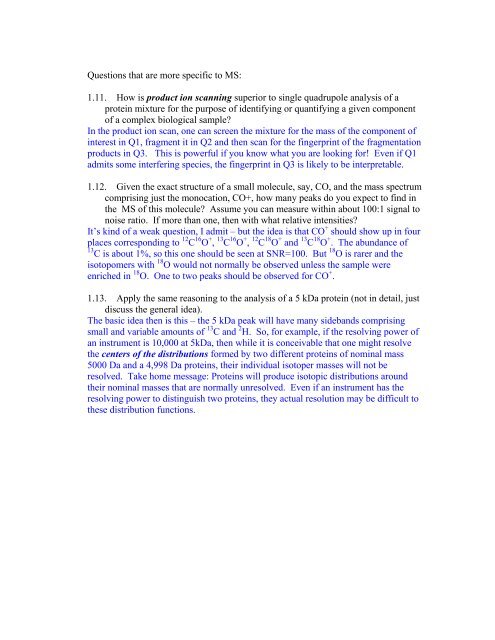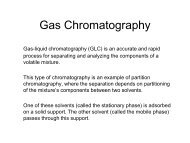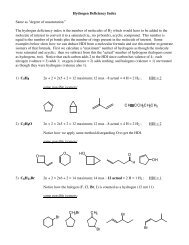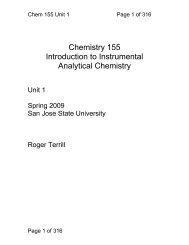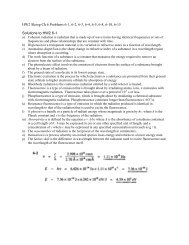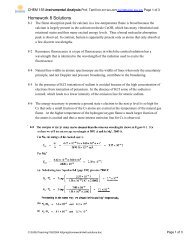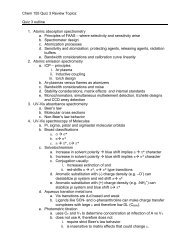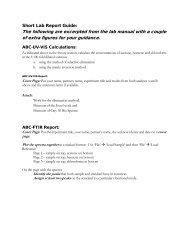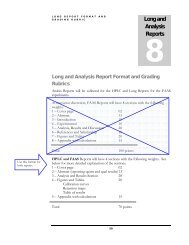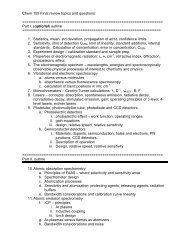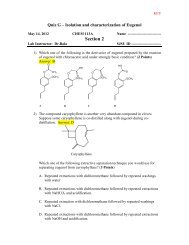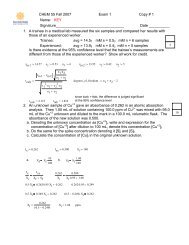1.5. Distinuish between a stable iso<strong>to</strong>pic label and a radioiso<strong>to</strong>pic label. Why arestable iso<strong>to</strong>pic labels used in MS?Radioiso<strong>to</strong>pes are those that decay by alpha, beta, gamma, electron capture, positronemission etc. All but pure gamma emitters change chemical identities and massesduring this transition. The transition can make the radioiso<strong>to</strong>pe detectable by avariety of means (scintillation counting, x-ray film etc.) But these mass changesdefeat the resolution desired in MS iso<strong>to</strong>pe dilution. Radioiso<strong>to</strong>pes are dangerous,expensive and require special handling1.6. Define proteomics.Proteomics refers <strong>to</strong> the measurement of the broad inven<strong>to</strong>ry of proteins expressed ina given organism or cell line. For example, proteomics may refer <strong>to</strong> theidentification, detection and quantitation of all of proteins and post-translationalmodifications observed in a given cell line at a given time.1.7. Define polynucleotide, polypeptide and protein.DNA nucleotides comprise adenine (A), guanine (G), thymine (T) and cy<strong>to</strong>sine (C).Polynucleotides comprise polymers with variable A,G,T and C subunits linked byphosphate esters of deoxyribose (RNA uses uracil (U) and ribose). Oligonucleotidesare short (less than about 20 or so units) of AGTC.Proteins are formed from amino acids linked by peptide (amide) bonds. Proteins aremade by living cells – polypeptides are short (< about 20?) chains of amino acids thatmay or may not be biogenic.1.8. Would you describe the contents of a cell as:1.8.1. A solution of one or two different proteins.1.8.2. A solution of a few polynucleotides and polypeptides.1.8.3. A solution with a few mono and polysaccharides, lipids, glycolipids,proteins, glycoproteins, peptides, RNA, DNA, small molecule electrolytesand metabolites and basically a very complex thing.1.9. How does chroma<strong>to</strong>graphy help <strong>to</strong> simplify the analysis of a cell’s contents?Analysis of a cellular contents is a very challenging problem – usually requiring avariety of fractionations such as centrifugation <strong>to</strong> separate organelles, salting out ofproteins, dialaysis <strong>to</strong> remove salts and small molecules etc. This may reduce thedimension of the problem <strong>to</strong> just 10’s <strong>to</strong> hundreds of abundant chemical species.Chroma<strong>to</strong>graphy (HPLC in one of its many incarnations) can then reduce this by afac<strong>to</strong>r of ten or better.1.10. How does mass spectrometry help?MS gives sensitively and possibly quantitatively reports the masses of thebiomolecule constituents of the mixture. If two biomolecules have different massesthen they are resolved even if they co-elute. Mass may not seem like the most amplydescriptive property of a biomolecule, but it’s not bad! Fragmentation patterns fromprotein databases can be identified by computer analysis rapidly and faithfully.
<strong>Questions</strong> that are more specific <strong>to</strong> MS:1.11. How is product ion scanning superior <strong>to</strong> single quadrupole analysis of aprotein mixture for the purpose of identifying or quantifying a given componen<strong>to</strong>f a complex biological sample?In the product ion scan, one can screen the mixture for the mass of the component ofinterest in Q1, fragment it in Q2 and then scan for the fingerprint of the fragmentationproducts in Q3. This is powerful if you know what you are looking for! Even if Q1admits some interfering species, the fingerprint in Q3 is likely <strong>to</strong> be interpretable.1.12. Given the exact structure of a small molecule, say, CO, and the mass spectrumcomprising just the monocation, CO+, how many peaks do you expect <strong>to</strong> find inthe MS of this molecule? Assume you can measure within about 100:1 signal <strong>to</strong>noise ratio. If more than one, then with what relative intensities?It’s kind of a weak question, I admit – but the idea is that CO + should show up in fourplaces corresponding <strong>to</strong> 12 C 16 O + , 13 C 16 O + , 12 C 18 O + and 13 C 18 O + . The abundance of13 C is about 1%, so this one should be seen at SNR=100. But 18 O is rarer and theiso<strong>to</strong>pomers with 18 O would not normally be observed unless the sample wereenriched in 18 O. One <strong>to</strong> two peaks should be observed for CO + .1.13. Apply the same reasoning <strong>to</strong> the analysis of a 5 kDa protein (not in detail, justdiscuss the general idea).The basic idea then is this – the 5 kDa peak will have many sidebands comprisingsmall and variable amounts of 13 C and 2 H. So, for example, if the resolving power ofan instrument is 10,000 at 5kDa, then while it is conceivable that one might resolvethe centers of the distributions formed by two different proteins of nominal mass5000 Da and a 4,998 Da proteins, their individual iso<strong>to</strong>per masses will not beresolved. Take home message: Proteins will produce iso<strong>to</strong>pic distributions aroundtheir nominal masses that are normally unresolved. Even if an instrument has theresolving power <strong>to</strong> distinguish two proteins, they actual resolution may be difficult <strong>to</strong>these distribution functions.


